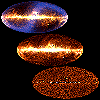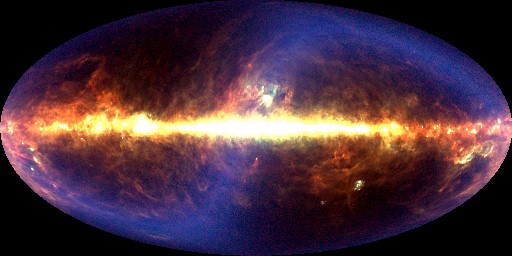 Press Release
Press Release
These three pictures are maps of the full sky as seen in infrared light.
The top two are composite images taken in wavelengths of 60, 100, and 240 micrometers.
The 60-micrometer brightness is shown in blue, the 100-micrometer brightness in green, and the 240-micrometer brightness in red.
The bottom image shows just the 240-micrometer brightness after foreground light from the Solar System and Galaxy has been removed.
The images were compiled from data taken between December 1989 and September 1990 by the Diffuse Infrared Background Experiment (DIRBE) on board NASA's Cosmic Background Explorer (COBE). They illustrate the steps scientists used to find the cosmic infrared background, which is a radiative fossil containing cumulative starlight which now appears in the infrared due to the cosmic red shift and by absorption and re-emission by dust in the universe since the Big Bang.

Photo No.: STScI-PRC98-01a
The picture above represents the brightness of the full sky as seen in infrared light. The bright yellow-orange line across the center of the image arises from interstellar dust in the plane of our Milky Way Galaxy, with the center of the Galaxy at the center of the image. The red color above and below this line shows additional wispy clouds of interstellar dust. The blue S-shaped color arises from interplanetary dust in the Solar System.

Photo No.: STScI-PRC98-01b
The picture above represents a view of the sky after the foreground glow of the Solar System dust has been extracted. This image is dominated by emission from interstellar dust in the Milky Way Galaxy. The two bright objects in the center of the lower right quadrant are nearby galaxies, the Large and Small Magellanic Clouds.

Photo No.: STScI-PRC98-01c
After the infrared light from our Solar System and galaxy has been removed, what remains is a uniform cosmic infrared background. The line across the center is an artifact from removal of Galactic light. The DIRBE team reports detection of this cosmic background light also at 140 micrometers, and has set limits to its brightness at eight other infrared wavelengths from 1.25 to 100 micrometers.
Credit: Michael Hauser (Space Telescope Science Institute),
the COBE/DIRBE Science Team, and NASA
For higher-resolution versions of the pictures in this release, link to
COBE's Infrared View Of The Universe
(HubbleSite - NewsCenter, PRC98-01, January 9, 1998).
![]() The Space Telescope Science Institute
is operated by the Association of Universities for Research in Astronomy, Inc. (AURA),
The Space Telescope Science Institute
is operated by the Association of Universities for Research in Astronomy, Inc. (AURA),
for NASA, under contract with the
Goddard Space Flight Center, Greenbelt, MD.
The Hubble Space Telescope is a project of international cooperation between NASA and the
European Space Agency (ESA).
![]() Updated: January 16 '98
Updated: January 16 '98
Best seen with MS Internet Explorer.
Back: ARVAL's Gallery (COBE's Infrared View Of The Universe)
Messages: